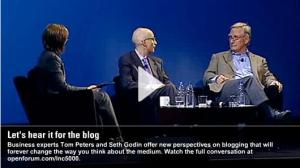 Yesterday I was fortunate enough to be invited to a half day session with British Library bloggers and Social Media legend Euan Semple.
Yesterday I was fortunate enough to be invited to a half day session with British Library bloggers and Social Media legend Euan Semple.
I suppose as the first permanent blogger at The British Library it was perhaps natural for them to invite me along. We currently have sixteen active bloggers in The British Library, but quite a few of our curators are planning to start blogs in the near future. Personally, I would like to see every subject expert within The British Library blogging passionately on their specialist topic.
I have known Euan for quite a few years, and have watched his reputation as a Social Media consultant grow. His experience is particularly relevant for The British Library as his expertise was forged in the comparably challenging environment of the BBC. As head of Knowledge Management, he was expected to invest in traditional large scale IT solutions such as document management systems. Instead he experimented with (mainly free) web based solutions. This somewhat anarchic approach did not always endear him to his bosses.
‘The project has encountered opposition from people who question whether the organisation should adopt technologies and processes that are so new and potentially disruptive to the existing structure.’ FT. com Encouraging information sharing, By Kate Mackenzie, January 24 2006
However, many of these new social media tools were avidly adopted by BBC staff and made a big impact on knowledge sharing within (and eventually outside) of the organisation.
The British Library is in a similar position now. Senior management realise the importance of social media, but are understandably nervous about the lack of control that comes with it.
Certainly for me, getting my blog started here was something of a challenge. Ironically, it was never my intention to create a permanent blog. My reason for starting was to show my colleague Steve Van Dulken how easy it was to start and maintain one. However, by the time I had managed to convince him to go ahead, I was already addicted.
Rather than wait the six months I was told it would take to set up a British Library TypePad account, I went ahead on my own using a free WordPress account.
I have picked up lots of useful tips during the three years I have been posting. In particular the importance of using titles with clear meanings (the ‘Ronseal‘ approach again). Also regular use of images and videos to liven up the page. Finally, lots of (relevant) links out to content, to attract Google rankings, and hopefully links back too.
I seem to have strayed somewhat away from the point of this post, so let’s get back on track.
Euan was a very relaxed and informal host of the morning, but it became clear early on that he has immense experience and knowledge. Particularly of the challenge of introducing social media activities into large organisations.
He recommended a baby steps approach, rather than attempting to implement an enormous project, using my new favourite phrase ‘Trojan mice’. Related to this is the principle of control versus influence with the knowledge that hyperlinks undermine hierarchies.
One discussion thread during the morning that really surprised me, given my blog challenges, was that some of my colleagues felt there was a pressure from above to blog. However, as Euan pointed out, no less a figure than Peter Drucker stated, ‘In the knowledge economy, everyone is a volunteer, but we have trained our managers to manage conscripts.’ Delphi’s IKMS event in San Diego, 1998.
According to Euan, seeing institutions engaging with the digital world can be like ‘watching your dad dancing at a disco’. Painfully embarrassing in other words.
One of the biggest challenges facing any institutional blogger is to find the balance of their individual view against their organisations viewpoint. And I am wondering where this post sits in regard to that invisible line.
Below is a list of some of the key topics we covered during the morning. In my view they are issues all institutional bloggers need to review and address:
– How to generate new material. Any ‘forced’ content will be spotted by your readers.
– How to keep your blog fresh and interesting. How to develop a feel for what your audience is looking for and write about subjects that pique their interest.
– How to find your voice. Blogs work best when they express opinion and take a position on subjects. How do you make your blog sound authentic and have a personality.
– How to balance the individual and the organisation. Given that blogging encourages an individual voice how do you balance that with the needs of the institution? How do you achieve a personal tone while writing for an organisation with a brand to protect?
– How to attract an audience. How do you draw people to your blog? How do you discover and attract people who will find your blog interesting? How do you build a relationship with that audience?
– How to encourage a conversation. Comments are often the lifeblood of a good blog. How do you make it more likely that people will comment on your posts? How do you keep the conversation going when they do? How do you handle negative comments?
– How to use other social media tools to enhance your blogging. Blogs are just part of the social media ecosystem. How do you use Twitter to add value to your blog? How do you use Facebook to find and increase your audience? How do you use services like Posterous or Ping.fm to integrate your various activities?









